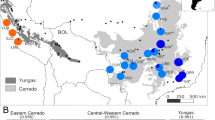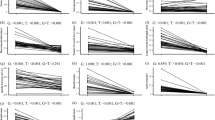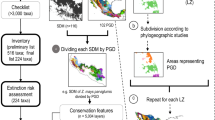Abstract
Inbred F3 and F4 families from a cross between two contrasting ecotypes of Crepis tectorum were replicated in two regimes in a glasshouse to determine whether genetic tradeoffs within the reaction norm favour genetic differentiation over phenotypic plasticity in this species. There was no tradeoff in reproductive fitness (flower production) across light regimes but genetic cross-environment correlations approached unity for a wide range of characters subject to divergent selection across habitats, suggesting little genetic variation in plasticity and a limited opportunity for selection to favour broadly adapted genotypes capable of attaining the optimum phenotype in every environment. The presence of genotype-environment interaction without large changes in the ranking of genotypes over light regimes indicates a greater potential for evolutionary change in environmental sensitivity although developmental constraints may limit the range of phenotypes that can be expressed in a character. A selection analysis was conducted to determine how the average reaction norm would evolve in this system. Whereas the relationship between each trait and reproductive fitness was environment-specific, there was no change in the direction of selection between light regimes. Given the genetic correlation structure observed, one would expect some of the genetic response in one environment to carry over to the other environment.
Similar content being viewed by others
Article PDF
References
Andersson, S. 1989a. Phenotypic plasticity in Crépis tectorum (Asteraceae). Pl Syst Evol, 168, 19–38.
Andersson, S. 1989b. Life-history evolution in Crépis tectorum (Asteraceae). Oecologia (Berl), 80, 540–545.
Andersson, S. 1989c. The evolution of self-fertility in Crépis tectorum (Asteraceae). Pl Syst Evol, 168, 227–236.
Andersson, S. 1990. A phenetic study of Crépis tectorum in Fennoscandia and Estonia. Nord J Bot, 9, 589–600.
Andersson, S. 1991. Geographical variation and genetic analysis of leaf shape in Crépis tectorum (Asteraceae). Pl Syst Evol, 178, 247–258.
Andersson, S. 1992. Phenotypic selection in a population of Crépis tectorum ssp. pumila. Can J Bot, 70, 89–95.
Andersson, S. 1993. Morphometric differentiation, patterns of interfertility and the genetic basis of character evolution in Crépis tectorum (Asteraceae). Pl Syst Evol, 184, 27–40.
Ayres, M P, and Thomas, D L. 1990. Alternative formulations of the mixed-model ANOVA applied to quantitative genetics. Evolution, 44, 221–226.
Babcock, E B. 1947. The genus Crépis I–II. University of California Press, Berkeley, CA.
Bennett, A F, Dao, K M, and Lenski, R E. 1990. Rapid evolution in response to high-temperature selection. Nature, 346, 79–81.
Björkman, O, and Holmgren, P. 1963. Adaptability of the photosynthetic apparatus to light intensity in ecotypes from exposed and shaded habitats. Physiol Plant, 16, 889–914.
Bradshaw, A D. 1965. Evolutionary significance of phenotypic plasticity in plants. Adv Genet, 13, 115–155.
Bulmer, M. 1985. Mathematical Quantitative Genetics. Clarendon Press, Oxford.
Conover, D O, Van Voorhees, D A, and Ehtisham, A. 1992. Sex ratio selection and the evolution of environmental sex determination in laboratory populations of Menidia menidia. Evolution, 46, 1722–1730.
Cook, S A, and Johnson, M P. 1968. Adaptation to heterogeneous environments. I. Variation in heterophylly in Ranunculus flammula L. Evolution, 22, 496–516.
Falconer, D S. 1952. The problem of environment and selection. Am Nat, 86, 293–298.
Falconer, D S. 1981. Introduction to Quantitative Genetics, 2nd edn. Longman, London.
Falconer, D S. 1990. Selection in different environments: effects on environmental sensitivity (reaction norm) and on mean performance. Genet Res, 56, 57–70.
Fry, J D. 1990. Tradeoffs in fitness on different hosts: evidence from a selection experiment with a phytophagous mite. Am Nat, 136, 569–580.
Fry, J D. 1992. The mixed-model analysis of variance applied to quantitative genetics: biological meaning of the parameters. Evolution, 46, 540–550.
Fry, J D. 1993. The ‘general vigor’ problem: can antagonistic pleiotropy be detected when genetic covariances are positive? Evolution, 47, 327–333.
Futuyma, D J, and Moreno, G. 1988. The evolution of ecological specialization. Ann Rev Ecol Syst, 19, 207–233.
Gabriel, W, and Lynch, M. 1992. The selective advantage of reaction norms for environmental tolerance. J Evol Biol, 5, 41–59.
Gomulkiewicz, R, and Kirkpatrick, M. 1992. Quantitative genetics and the evolution of reaction norms. Evolution, 46, 390–411.
Gupta, A P, and Lewontin, R C. 1982. A study of reaction norms in natural populations of Drosophila pseudoobscura. Evolution, 36, 934–948.
Hickman, J C. 1972. Environmental unpredictability and plastic energy allocation strategies in the annual Polygonum cascadeuse (Polygonaceae). J Ecol, 63, 689–701.
Hocking, R R. 1973. A discussion of the two-way mixed model. Am Statist, 27, 148–152.
Khan, M Akram, and Bradshaw, A D. 1976. Adaptation to heterogeneous environments. II. Phenotypic plasticity in response to spacing in Linum. Aust J Agric Res, 27, 519–531.
Khan, M, Akram Antonovics, J, and Bradshaw, A D. 1976. Adaptation to heterogeneous environments. III. The inheritance of response to spacing in Flax and Linseed (Linum usitatissimum). Aust J Agric Res, 27, 649–659.
Lacey, E P, Real, L, Antonovics, J, and Heckel, D G. 1983. Variance models in the study of life histories. Am Nat, 122, 114–131.
Lande, R, and Arnold, S J. 1983. The measurement of selection on correlated characters. Evolution, 37, 1210–1226.
Mather, K, and Jinks, J L. 1982. Biometrical Genetics, 3rd edn. Chapman and Hall, London.
Mazer, S J, and Schick, C T. 1991. Constancy of population parameters for life history and floral traits in Raphanus sativus L. 1. Norms of reaction and the nature of genotype by environment interactions. Heredity, 67, 143–156.
Miller, T E, and Schemske, D W. 1990. An experimental study of competitive performance in Brassica rapa (Cruciferae). Am J Bot, 11, 993–998.
Mooney, H A. 1980. Photosynthetic plasticity of populations of Heliotropium curassavicum L. originating from differing thermal regimes. Oecologia (Berl), 45, 372–376.
Najda, H O, Darwent, A L, and Hamilton, G. 1982. The biology of Canadian weeds 54. Crépis tectorum Can J Plant Sci, 62, 473–481.
Newman, R A. 1988. Adaptive plasticity in development of Scaphiopus couchii tadpoles in desert ponds. Evolution, 42, 774–783.
Platenkamp, G A J, and Shaw, R G. 1992. Environmental and genetic constraints on adaptive population differentiation in Anthoxanthum odoratum. Evolution, 46, 341–352.
Robertson, A. 1959. The sampling variance of the genetic correlation coefficient. Biometrics, 15, 469–485.
Rose, M R. 1984. Genetic covariation in Drosophila life history: Untangling the data. Am Nat, 123, 565–569.
SAS. 1985. SAS Users Guide: Statistics. SAS Institute Inc., Cary, NC USA.
Scheiner, S M, and Lyman, R F. 1989a. The genetics of phenotypic plasticity. I. Heritability. J Evol Biol, 2, 95–107.
Scheiner, S M, and Lyman, R F. 1989b. The genetics of phenotypic plasticity. II. Response to selection. J Evol Biol, 3, 23–50.
Schlichting, C D. 1986. The evolution of phenotypic plasticity in plants. Ann Rev Ecol Syst, 17, 667–693.
Schlichting, C D, and Levin, D A. 1990. Phenotypic plasticity in Phlox. III. Variation among natural population of P. drummondii. J Evol Biol, 3, 411–428.
Schmalhausen, I I. 1949. Factors of Evolution. Blakeston, PA, USA.
Schmitt, J, Niles, J, and Wulff, R D. 1992. Norms of reaction of seed traits to maternal environments in Plantago lanceolata. Am Nat, 139, 451–466.
Service, P M, and Rose, M R. 1985. Genetic covariation among life-history components: the effect of novel environments. Evolution, 39, 943–945.
Shaw, R G. 1986. Response to density in a wild population of the perennial herb Salvia lyrata: variation among families. Evolution, 40, 492–505.
Shaw, R G, and Platenkamp, G A J. 1993. Quantitative genetics of competitive ability in Nemophila menziesii. Evolution, 47, 801–812.
Stearns, S C. 1989. The evolutionary significance of phenotypic plasticity. Bioscience, 39, 436–445.
Stebbins, G L. 1950. Variation and Evolution in Plants. Columbia, New York.
Sultan, S E. 1987. Evolutionary implications of phenotypic plasticity in plants. Evol Biol, 21, 127–178.
Trexler, J C, and Travis, J. 1990. Phenotypic plasticity in the sailfin molly, Poecilia latipinna (Pisces: Poeciliidae). I. Field experiments. Evolution, 44, 143–156.
Van Tienderen, P H. 1991. Evolution of generalists and specialists in spatially heterogeneous environments. Evolution, 45, 1317–1331.
Via, S. 1984a. The quantitative genetics of polyphagy in an insect herbivore. I. Genotype-environment interaction in larval performance on different host plant species. Evolution, 38, 881–895.
Via, S. 1984b. The quantitative genetics of polyphagy in an insect herbivore. II. Genetic correlations in larval performance within and among host plants. Evolution, 38, 896–905.
Via, S. 1991. The genetic structure of host plant adaptation in a spatial patchwork: demographic variability among reciprocally transplanted pea aphid clones. Evolution, 45, 827–852.
Via, S, and Lande, R. 1985. Genotype-environment interaction and the evolution of phenotypic plasticity. Evolution, 39, 505–522.
Waddington, C H. 1959. Canalization of development and genetic assimilation of acquired characters. Nature, 183, 1654–1655.
Weis, A E, and Gorman, W L. 1990. Measuring selection on reaction norms: an exploration of the Eurosta-Solidago system. Evolution, 44, 820–831.
Westerman, J M. 1970. Genotype-environment interaction and developmental regulation in Arabidopsis thaliana. TV. Wild material: analysis. Heredity, 26, 383–395.
Yamada, Y. 1962. Genotype by environment interaction and genetic correlation of the same trait under different environments. Jpn J Genet, 37, 489–509.
Zimmerman, C A. 1976. Growth characteristics of weediness in Portulaca oleracea. Ecology, 57, 964–974.
Author information
Authors and Affiliations
Rights and permissions
About this article
Cite this article
Andersson, S., Shaw, R. Phenotypic plasticity in Crepis tectorum (Asteraceae): genetic correlations across light regimens. Heredity 72, 113–125 (1994). https://doi.org/10.1038/hdy.1994.17
Received:
Issue date:
DOI: https://doi.org/10.1038/hdy.1994.17
Keywords
This article is cited by
-
Genetic structure and genetic diversity of the endangered grassland plant Crepis mollis (Jacq.) Asch. as a basis for conservation management in Germany
Conservation Genetics (2018)
-
Detecting small environmental differences: risk-response curves for predator-induced behavior and morphology
Oecologia (2008)
-
Modelling phenotypic plasticity. II. Do genetic correlations matter?
Heredity (1996)
-
Genetic correlations and reaction norms in wing pattern of the tropical butterfly Bicyclus anynana
Heredity (1994)



